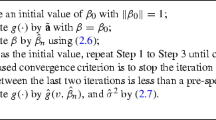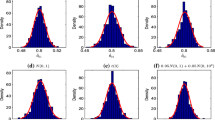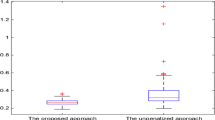Abstract
We investigate the estimators of parameters of interest for a single-index varying-coefficient model. To estimate the unknown parameter efficiently, we first estimate the nonparametric component using local linear smoothing, then construct an estimator of parametric component by using estimating equations. Our estimator for the parametric component is asymptotically efficient, and the estimator of nonparametric component has asymptotic normality and optimal uniform convergence rate. Our results provide ways to construct confidence regions for the involved unknown parameters. The finite-sample behavior of the new estimators is evaluated through simulation studies, and applications to two real data are illustrated.



Similar content being viewed by others
References
Arnold, S.f.: The Theory of Linear Models and Multivariate Analysis. Wiley, New York (1981)
Cai, Z.W., Fan, J.Q., Li, R.Z.: Efficient estimation and inferences for varying-coefficient models. J. Am. Stat. Assoc. 95, 888–902 (2000a)
Cai, Z., Fan, J., Yao, Q.: Functional-coefficient regression models for nonlinear time series. J. Am. Stat. Assoc. 95, 941–956 (2000b)
Carroll, R.J., Fan, J., Gijbels, I., Wand, M.P.: Generalized partially linear single-index models. J. Am. Stat. Assoc. 92, 477–489 (1997)
Chang, Z.Q., Xue, L.G., Zhu, L.X.: On an asymptotically more efficient estimation of the single-index model. J. Multivar. Anal. 101, 1898–1901 (2010)
Chen, R., Tsay, S.: Functional-coefficient autoregressive models. J. Am. Stat. Assoc. 88, 298–308 (1993)
Chiou, J.M., Müller, H.G.: Quasi-likelihood regression with unknown link and variance functions. J. Am. Stat. Assoc. 93, 1376–1387 (1998)
Cui, X., Härdle, W.K., Zhu, L.X.: The EFM approach for single-index models. Ann. Stat. 39(3), 1658–1688 (2011)
Diggle, P.J.: Time Series: A Biostatistical Introduction. Oxford University Press, Oxford (1990), pp. 387
Doukhan, P., Massart, P., Rio, E.: Invariance principles for absolutely regular empirical processes. Ann. Inst. Henri Poincaré Probab. Stat. 31, 393–427 (1995)
Fan, J., Gijbels, I.: Local Polynomial Modeling and Its Applications. Chapman and Hall, London (1996)
Fan, J.Q., Yao, Q.W., Cai, Z.W.: Adaptive varying-coefficient linear models. J. R. Stat. Soc. B 65, 57–80 (2003)
Fan, J.Q., Zhang, W.Y.: Statistical estimation in varying-coefficient models. Ann. Stat. 27, 1491–1518 (1999)
Härdle, W., Hall, P., Ichimura, H.: Optimal smoothing in single-index models. Ann. Stat. 21, 157–178 (1993)
Hastie, T.J., Tibshirani, R.: Varying-coefficient models. J. R. Stat. Soc. B 55, 757–796 (1993)
Huang, J.Z., Shen, H.P.: Functional coefficient regression models for nonlinear time series: a polynomial spline approach. Scand. J. Stat. 31, 515–535 (2004)
Hristache, M., Juditsky, A., Spokoiny, V.: Direct estimation of the index coefficient in a single-index model. Ann. Stat. 29, 595–623 (2001)
Ichimura, H.: Semiparametric least squares(SLS) and weighted SLS estimation of single-index models. J. Econom. 58, 71–120 (1993)
Li, K.C.: Sliced inverse regression for dimension reduction (with discussion). J. Am. Stat. Assoc. 86, 316–342 (1991)
Loève, M.: Probability Theory I, 4th edn. Springer, Berlin (2000)
Lu, Z.D., Tjøstheim, D., Yao, Q.W.: Adaptive varying-coefficient linear models for stochastic processes: Asymptotic theory. Stat. Sin. 17, 177–197 (2007)
Masry, E., Tjøstheim, D.: Nonparametric estimation and identification of nonlinear ARCH time series: Strong convergence and asymptotic normality. Econom. Theory 11, 258–289 (1995)
Rio, E.: The functional law of the iterated logarithm for stationary strongly mixing sequence. Ann. Probab. 23, 1188–1203 (1995)
Stute, W.: A law for the logarithm of kernel density estimators. Ann. Probab. 10, 414–422 (1982)
Wang, J.L., Xue, L.G., Zhu, L.X., Chong, Y.S.: Estimation for a partial-linear single-index model. Ann. Stat. 38, 246–274 (2010)
Wang, Q.H., Xue, L.G.: Statistical inference partially-varying-coefficient single-index model. J. Multivar. Anal. 102, 1–19 (2011)
Weisberg, S., Welsh, A.H.: Adapting for the missing linear link. Ann. Stat. 22, 1674–1700 (1994)
Wu, C.O., Chiang, C.T., Hoover, D.R.: Asymptotic confidence regions for kernel smoothing of a varying-coefficient model with longitudinal data. J. Am. Stat. Assoc. 93, 1388–1402 (1998)
Xia, Y.C., Li, W.K.: On single-index coefficient regression models. J. Am. Stat. Assoc. 94, 1275–1285 (1999)
Xia, Y., Tong, H., Li, W.K., Zhu, L.X.: An adaptive estimation of dimension reduction space. J. R. Stat. Soc. B 64, 363–410 (2002)
Xue, L.G., Wang, Q.H.: Empirical likelihood for single-index varying-coefficient models. Bernoulli (2012, to appear)
Xue, L.G., Zhu, L.X.: Empirical likelihood for single-index model. J. Multivar. Anal. 97, 1295–1312 (2006)
Xue, L.G., Zhu, L.X.: Empirical likelihood for a varying coefficient model with longitudinal data. J. Am. Stat. Assoc. 102, 642–654 (2007)
Zhu, L.X., Fang, K.T.: Asymptotics for the kernel estimates of sliced inverse regression. Ann. Stat. 24, 1053–1067 (1996)
Yu, Y., Ruppert, D.: Penalized spline estimation for partially linear single-index models. J. Am. Stat. Assoc. 97, 1042–1054 (2002)
Acknowledgements
We are grateful for the many detailed suggestions of the editor, the associate editor and the referees, which led to significant improvements of the paper.
Liugen Xue’s research was supported by the National Natural Science Foundation of China (11171012), the Science and Technology Project of the Faculty Adviser of Excellent Ph.D. Degree Thesis of Beijing (20111000503) and the Beijing Municipal Education Commission Foundation (KM201110005029). Zhen Pang’s research was supported by a grant from the Ministry of Education, Singapore.
Author information
Authors and Affiliations
Corresponding author
Appendix
Appendix
The following Lemma 1 is similar to Lemma 2 of Xia and Li (1999).
Lemma 1
Suppose that φ(u) is a bounded function and has bounded derivatives on the closed interval [a,b], and that {(U i ,ξ i )} is a strictly stationary and strongly mixing sequence with mixing coefficient α(n)=O(ρ n) for some 0<ρ<1. E|U i |r<∞, E|ξ i |r<∞ for all r>1, and the conditional densities \(f_{U_{1},U_{l}|\xi_{1},\xi_{l}}(u_{1},u_{l}|v_{1},v_{l})\) and \(f_{U_{1}|\xi_{1}}(u|v)\) are bounded for all l>1. If (C5) hold, then

where ψ i (u)=K h (U i −u)φ(U i )ξ i .
Proof of Theorem 1
By (2.6) and Lemma 1, and similar to the proof of Theorem 2 in Wang and Xue (2011), we can prove Theorem 1, and hence omit its proof. □
Let \(\mathcal{B}_{n}^{(r)}=\{\beta^{(r)}: \|\beta^{(r)}-\beta_{0}^{(r)}\|\leq c_{2}n^{-1/2}\}\) for some positive constant c 2. Denote \(\mathcal{G}=\{{\mathrm{g}}: \mathcal{U}_{w}\times\mathcal{B}\mapsto R^{q}\}\) and \(\|{\mathrm{g}}\|_{\mathcal{G}}=\sup_{u\in\mathcal{U}_{w},\beta^{(r)}\in \mathcal{B}_{n}^{(r)}}\|{\mathrm{g}}(u;\beta(\beta^{(r)})\|\). Since ∥β−β 0∥≤c 1 n −1/2 and \(\|\beta^{(r)}-\beta_{0}^{(r)}\|\leq c_{2}n^{-1/2}\) are equivalent when ∥β∥=1, from Theorem 1 we have \(\|\hat{\mathrm{g}}-{\mathrm{g}}_{0}\|_{\mathcal{G}}=o_{P}(1)\) and \(\|\hat{\dot{\mathrm{g}}}-\dot{\mathrm{g}}_{0}\|_{\mathcal{G}}=o_{P}(1)\), hence we can assume that g lie in \(\mathcal{G}_{\delta}\) with δ=δ n →0 and δ>0, where
Let \({\mathrm{g}}_{0}(\beta^{T}X;\beta)=E\{{\mathrm{g}}_{0}(\beta _{0}^{T}X)|\beta^{T}X\}\), \(\dot{\mathrm{g}}_{0}(\beta^{T}X;\beta)= E\{\dot{\mathrm{g}}_{0}(\beta_{0}^{T}X)|\beta ^{T}X\}\),

and

It is easily known that \(\mathrm{g}_{0}(\beta_{0}^{T}X;\beta_{0})=\mathrm{g}_{0} (\beta_{0}^{T}X)\), \(\dot{\mathrm{g}}_{0}(\beta_{0}^{T}X;\beta_{0})=\dot{\mathrm{g}}_{0}(\beta_{0}^{T}X)\). Define the functional derivative ϖ(g0(⋅;β),β (r)) of Q(ĝ,β (r)) with respect to g(⋅;β) at g0(⋅;β) in the direction g(⋅;β)−g0(⋅;β) by

We have

Lemma 2
Suppose that conditions (C1)–(C6) hold. Then
where A is defined in Theorem 2,

Proof
We first prove (A.4). Denote \(r_{n}({\mathrm{g}},\beta^{(r)})= \sqrt{n}\{Q_{n}({\mathrm{g}},\beta ^{(r)})-Q({\mathrm{g}},\beta ^{(r)})\}\). Noting that \(Q({\mathrm{g}}_{0},\beta_{0}^{(r)})=0\), we clearly have
It can be shown that the empirical process \(\{r_{n}({\mathrm{g}},\beta^{(r)}):{\mathrm{g}}\in\mathcal{G}_{1},\beta ^{(r)}\in\mathcal{B}_{1}^{(r)}\}\) has the stochastic equicontinuity, where \(\mathcal{B}_{1}^{(r)}=\{\beta^{(r)}: \|\beta^{(r)}-\beta^{(r)}_{0}\|\leq c_{2}\}\) and \(\mathcal{G}_{1}\) are defined in (A.1) with δ=1, which are subsets of \(\mathcal{B}\) and \(\mathcal{G}\), respectively, and suffices for proof of (A.4) as δ<1 for n large enough by δ→0. This stochastic equicontinuity follows by checking the conditions of Theorem 1 in Doukhan et al. (1995). Therefore, we have \(r_{n}({\mathrm{g}},\beta^{(r)})-r_{n}({\mathrm{g}}_{0},\beta_{0}^{(r)})=o_{P}(1)\), uniformly for \({\mathrm{g}}\in\mathcal{G}_{1}\) and \(\beta^{(r)}\in\mathcal{B}_{1}^{(r)}\). This together with (A.8) proves (A.4).
We now prove (A.5). It follows from (A.3) that

Therefore, from Theorem 1 we can prove (A.5).
From condition (C2) and Theorem 1, it is easy to prove (A.6). We now prove (A.7). Let f 0(u) denote the density function of \(\beta_{0}^{T}X\). Similar to the proof of Theorem 1 in Wang and Xue (2011), we can prove

uniformly for \(u\in\mathcal{U}_{w}\) and \(\beta\in\mathcal{B}_{n}^{(r)}\), where c n =n −1/2+h 2 and D(u) is defined in condition (C6).
By (A.3) and using the dominated convergence theorem (Loève 2000), we can obtain

where C(⋅) and μ 2 are defined in (C6) and Theorem 3, respectively. This together with (A.2) and the definition of \(M_{4}(\beta_{0}^{(r)})\) proves that

where \(\zeta_{i}=V_{i} - {C}(\beta_{0}^{T}X_{i}){D}^{-1}(\beta_{0}^{T}X_{i})Z_{i}\) and \(V_{i}= J_{\beta_{0}^{(r)}}^{T}X_{i}\dot{\mathrm{g}}_{0}^{T}(\beta _{0}^{T}X_{i})Z_{i}w(\beta_{0}^{T}X_{i})\). Therefore, by the central limit theorem for dependent data (Rio 1995) and Slutsky’s theorem, we get
This proves (A.7). The proof of Lemma 2 is completed. □
Proof of Theorem 2
Using the notations of Lemma 2, we have

In light of \(Q({\mathrm{g}}_{0},\beta_{0}^{(r)})=0\), we have by the Taylor expansion that
uniformly for \(\beta^{(r)}\in\mathcal{B}_{n}^{(r)}\). By (A.10), (A.11) and (A.4)–(A.6) of Lemma 2, we have
uniformly for \({\mathrm{g}}\in\mathcal{G}_{\delta}\) and \(\beta ^{(r)}\in\mathcal{B}_{n}\). Noting that \(Q_{n}(\hat{\mathrm{g}},\hat{\beta}^{(r)})=0\), from the foregoing equation we get
We now consider the estimator \(\hat{\beta}\). By simple calculation, we have
From (A.12) and (A.13), we have
This together with (A.7) of Lemma 2 proves Theorem 2. □
Proof of Theorem 3
By (A.9) and Theorem 4.4 of Masry and Tjøstheim (1995), we can complete the proof of Theorem. □
The proof of Theorem 4 is similar to the proof of the second part of Theorem 2 in Xia and Li (1999), and hence the detail is omitted.
Rights and permissions
About this article
Cite this article
Xue, L., Pang, Z. Statistical inference for a single-index varying-coefficient model. Stat Comput 23, 589–599 (2013). https://doi.org/10.1007/s11222-012-9332-x
Received:
Accepted:
Published:
Issue Date:
DOI: https://doi.org/10.1007/s11222-012-9332-x




